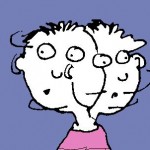 We’re all about practice, so I’ve spent the past few (very busy) weeks playing with the ideas in my last post: that in the creative process, distractibility might be more valuable than concentrated focus.
We’re all about practice, so I’ve spent the past few (very busy) weeks playing with the ideas in my last post: that in the creative process, distractibility might be more valuable than concentrated focus.
Since I’ve sometimes tended to see my own darting mind as a bit of a shameful liability, I thought I’d just let it go where it wanted and observe the results. What if these studies are correct, and the capacity for being distracted is a bit of a gift, rather than a shortcoming?
[At this point, unsure where to go next, I stopped and checked my email. Back again!]
I’ve noticed that shifting to another activity for a brief time seems to operate as a kind of mental “refresh” button. I don’t know if the distraction makes some obscure connection or shifts thinking to another part of the brain, but here I am, working at a good clip. My writing process seems to alternate between focused concentration and distracted poking about. Sometimes the oscillation is rapid; sometimes I’ll focus for ten or fifteen minutes at a time before skittering off.
[Listening to the birds outside. Noticing a bill I have to pay tomorrow. Going off to check an email that just came in. Be right back.]
All right, I’ll stop trying to be James Joyce here. But after my experiments of the last couple of weeks, it’s clear to me that the distractibility that my teachers found frustrating is a good friend to my own creative process.
New solutions come from new connections, and too much concentration at the wrong time can block our view of those unexpected relationships between seemingly random ideas. What if Newton had been too busy with calculation to notice that mythic apple’s fall? Or if Archimedes (the Greek, not the owl this time) had been too busy working on the problem of the king’s crown to bother taking a bath?
My advice: forget trying to be a good little pupil. Rush over to the window of your mind and see what’s going on in the schoolyard. Let’s show some gratitude for the ideas that float around us, unnoticed. And notice a few of them.


